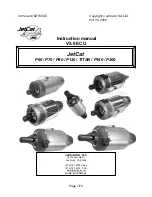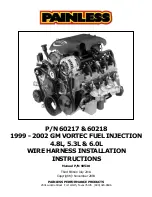
SEBU8605-01
111
Maintenance Section
Walk-Around Inspection
Inspect the breather tube (1) for damage. Ensure that
the outlet (2) is clean and free from any obstructions.
Ice can cause obstructions in adverse weather
conditions.
Inspect the Engine for Leaks and
for Loose Connections
A walk-around inspection should only take a few
minutes. When the time is taken to perform these
checks, costly repairs and accidents can be avoided.
For maximum engine service life, make a thorough
inspection of the engine compartment before starting
the engine. Look for items such as oil leaks or coolant
leaks, loose bolts, worn belts, loose connections, and
trash buildup. Make repairs, as needed:
•
The guards must be in the correct place. Repair
damaged guards or replace missing guards.
•
Wipe all caps and plugs before the engine is
serviced in order to reduce the chance of system
contamination.
NOTICE
For any type of leak (coolant, lube, or fuel) clean up the
fl
uid. If leaking is observed,
fi
nd the source and correct
the leak. If leaking is suspected, check the
fl
uid levels
more often than recommended until the leak is found
or
fi
xed, or until the suspicion of a leak is proved to be
unwarranted.
NOTICE
Accumulated grease and/or oil on an engine is a
fi
re
hazard. Remove the accumulated grease and oil. Re-
fer to this Operation and Maintenance Manual, “En-
gine - Clean” for more information.
•
Ensure that the cooling system hoses are correctly
clamped and that the cooling system hoses are
tight. Check for leaks. Check the condition of all
pipes.
•
Inspect the water pump for coolant leaks.
Note:
The water pump seal is lubricated by the
coolant in the cooling system. It is normal for a small
amount of leakage to occur, as the engine cools
down and the parts contract.
Excessive coolant leakage may indicate the need to
replace the water pump. Remove the water pump.
Refer to Disassembly and Assembly , “Water Pump -
Remove and Install”.
•
Inspect the lubrication system for leaks at the front
crankshaft seal, the rear crankshaft seal, the oil
pan, the oil
fi
lters, and the rocker cover.
•
Inspect the piping for the air intake system and the
elbows for cracks and for loose clamps. Ensure
that hoses and tubes are not contacting other
hoses, tubes, wiring harnesses.
•
Ensure that the areas around the rotating parts are
clear.
•
Inspect the alternator belts and any accessory
drive belts for cracks, breaks, or other damage.
•
Inspect the wiring harness for damage.
Belts for multiple groove pulleys must be replaced as
matched sets. If only one belt is replaced, the belt will
carry more load than the belts that are not replaced.
The older belts are stretched. The additional load on
the new belt could cause the belt to break.
High Pressure Fuel Lines
Contact with high pressure fuel may cause
fl
uid
penetration and burn hazards. High pressure fu-
el spray may cause a
fi
re hazard. Failure to fol-
low these inspection, maintenance and service in-
structions may cause personal injury or death.
After the engine has stopped, wait 10 minutes in
order to allow the fuel pressure to be purged from the
high-pressure fuel lines before any service or repair is
performed. If necessary, perform minor adjustments.
Repair any leaks from the low-pressure fuel system
and from the cooling, lubrication, or air systems.
Replace any high-pressure fuel line that has leaked.
Refer to Disassembly and Assembly Manual, “Fuel
Injection Lines - Install”.
If you inspect the engine in operation, always use
the proper inspection procedure in order to avoid
a
fl
uid penetration hazard. Refer to Operation and
Maintenance Manual, “General hazard Information”.
Visually inspect the high-pressure fuel lines for
damage or signs of fuel leakage. Replace any
damaged high-pressure fuel lines or high-pressure
fuel lines that have leaked.
Ensure that all clips on the high-pressure fuel lines
are in place and that the clips are not loose.
•
Inspect the rest of the fuel system for leaks. Look
for loose fuel line clamps.
•
Drain the water and the sediment from the fuel
tank on a daily basis in order to ensure that only
clean fuel enters the fuel system.












































